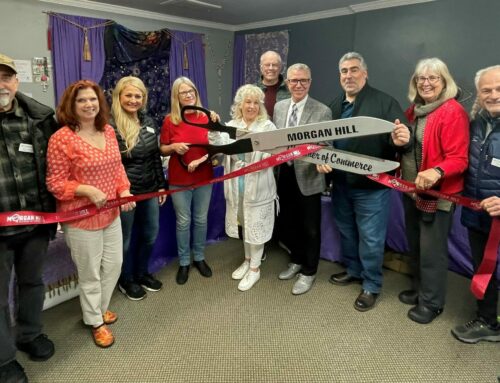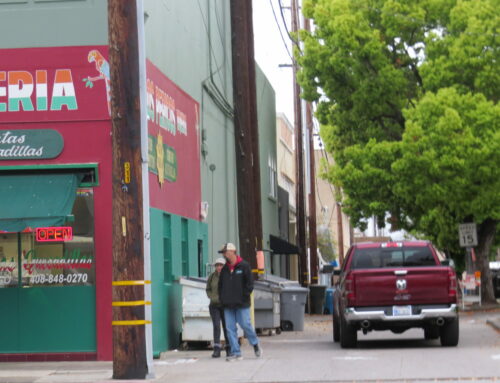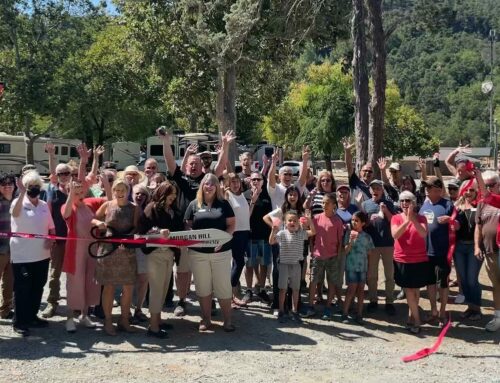Projects will save money on water and maintenance
Published in the April 27 – May 10, 2016 issue of Morgan Hill Life
By Marty Cheek

Photo by Marty Cheek
Workers plant new drought-tolerant shrubs as part of the city’s new landscaping program.
Expecting future dry spells in the coming years as global warming’s impact on California’s climate intensifies, the city of Morgan Hill is making many of its public facilities much more “water wise” with drought-tolerant landscaping and irrigation systems. The work being done on various properties showcases the fact that the community is on the cutting edge in the county with efforts to save water.
“In May last year at the height of the drought, people started realizing it’s a serious drought,”said Tony Eulo, program administrator for environmental services with the city of Morgan Hill. “City staff went to the city council and said, ‘We want to be a model for the community. We have pretty big areas of lawn that are not particularly (water) efficient. Th

Landscapers put in plants at the Community and Cultural Center as part of the city’s drought-tolerant demonstration garden. Photo by Marty Cheek
e lawns were not used to play on.’”
Various “water conservation demonstration garden” projects throughout the city have been finished or are now in the processing of being completed with the goal of reducing the impact of drought conditions, he said. Among those finished are frontage of the Dunne-Hill Fire Station and Morgan Hill Police Department sites and the waiting area outside the entrance to the Morgan Hill Dennis Kennedy Aquatics Center. The Aquatics Center and the Morgan Hill Civic Center have newly installed demonstration gardens. Among the more prominent projects is the landscaping currently being installed at the Community and Cultural Center land bordering the corner of East Dunne Avenue and Monterey Road in downtown Morgan Hill.
The various projects follow in line with the ecologically-friendly spirit of Morgan Hill and its residents, Eulo said. The projects will also in the long run save money on water and maintenance and hopefully encourage more residents to take steps to make their own yards and gardens more water wise by planting native plants and installing more efficient irrigation systems. The city has no estimate of how much water and money will be saved.
“It’s very consistent with the environmental philosophy of the city,” Eulo said. “Our council wants us to be leaders in water conservation, to be demonstrating the right practices, so it’s very consistent with what our community is about. I think that over the next couple of decades you’re going to see a big transformation in landscape as it becomes more and more natural looking and less water dependent. Water will tend to be increasingly unreliable.”
The areas chosen were places not used by people for recreation. Landscaping such as in the Community and Cultural Center’s plaza will be kept as lawns so that events such as the summer Friday Night Music Series can be held for people to enjoy the bands performing at the Downtown Amphitheater.
Kaela White, special projects manager with the city of Morgan Hill, has been involved in helping design and manage the project contractors who were hired by a bidding process to design the landscaping and install the new plants and irrigation systems. The Santa Clara Valley Water District provided some funding in the form of rebates for the various projects where lawns were taken out, helping reduce the cost to the city.
“What we did is apply with the district, so they came out to do an inspection and measured the lawns — it currently needed to have to be a living lawn,” White said. “What the project does is we take that lawn and convert it into a drought-tolerant landscape.”
The SCVWD required the city to follow specific guidelines in order to receive the rebates such as choosing certain types of plants and irrigation systems and have non-concrete permeable surfaces for water to go into the ground. Rebates were for amounts such as $21,636 for the Aquatics Center, $50,000 for the Community Center, and $41,794 for the Civic Center. Other projects also had rebates at lower amounts.

The new landscaping at Monterey Road and East Dunne Avenue should be completed next month.
Photo by Marty Cheek
Among the more interesting plants used to replace the lawns in the landscaping by the flag poles at the civic center is Kurapia (Lippia nodiflora), a new low-water groundcover first developed in Japan. It is suitable for drought conditions and is tolerant of different soils and a range of temperatures. It grows quickly to establish ground cover but is sterile, so unwanted seeding does not occur. People can step on it just like grass, White said.
“It’s brand new. A lot of people are not familiar with it because it’s just coming out on the market,” she said. “It still has that grass feel where you can walk on it, run on it and play on it, but it’s very low so you can mow it.”
The pavers used in the new walkway to the flag poles at the Civic Center are recovered from other projects such as spare pavers used for the Third Street project five years ago and leftover pavers from the Butterfield Boulevard extension, thus saving money instead of buying new paver stones, Eulo said.
Art work will also be installed at the Civic Center to accent the new landscaping. These will include a statue of slain Morgan Hill teen Tara Romero funded by her family and a “Harmony Tree” whimsical modern art piece that will turn with the wind blowing on it.
At the police station, the city used a lot of low-maintenance fescue grass in the landscaping upgrade, White said. “It’s a very nice terrain that’s easy on the eyes,” she said. “We decided we could do better and be a model for the community and demonstrate some water savings.”
As part of its water savings policy, the city has approved the installation at the Aquatics Center demonstration garden the removal of old turf and the installation of a KISSS Irrigation System, a next-generation technology that provides greater control over root zone conditions, dramatically reducing water consumption, Eulo said. The city received a $48,500 grant to demonstrate the new technology which is placed eight to 10 inches below the ground and allows water molecules to come up through capillary action to nourish the roots.
White earned a degree in environmental science at San Jose State University and worked for the SCVWD as an intern at the water conservation unit. She has also worked on landscape projects in the past, helping her with the various city projects, she said. The new landscaping at the Civic Center and the Community and Cultural Center will help to accent the fact that Morgan Hill is a community where people want to do their part to be good stewards of the natural world, she said.
“It really is awesome to work for a city that really cares about these things,” she said. “You walk downtown and you don’t really see any lawn, unless it’s in front of somebody’s house. You can really see the direction of where the city wants to go with this. What I appreciate is that they’re trying to make it easy and blend.”
Eulo said that the Morgan Hill City Council was supportive in the projects as well as encouraging more environmentally-friendly ideas in the future for city property.
“They’re very encouraging and they want to see us bring these ideas to them, and when we bring them they approve them,” he said. “I think that on this (water saving) issue we’re pretty far to the front in terms of other jurisdictions in the county. Every city has some, but I think this batch (of landscaping projects) really means we’re going to have a lot more gardens than other communities.”







